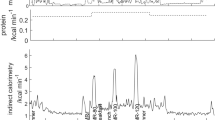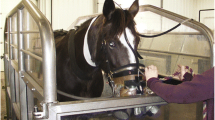Summary
The study was designed to determine the energy cost of walking over sandy and firm surfaces, and to compare the physiological responses of recruits recorded while walking over these surfaces.
The average oxygen intake of 11 young men walking over loose sand at 3 m.p.h. and carrying loads of about 50 lbs each (inclusive of clothes) was 1.973 litre/min. as compared with 1.101 litre/min. for walking on a firm surface, an increase of 80 per cent. The average pulse rate and rectal temperature were significantly higher during the march over sand (150 beats/min. and 101.5 °F respectively) than while walking over firm surfaces (127 beats/min. and 100.5 °F). The increased physiological strain was obvious. Most of the men were working at more than 50 per cent of their estimated maximum oxygen intakes while walking on sand, as a result of which their heart rates and rectal temperatures would have increased progressively with time.
Similar content being viewed by others
References
Bedford, T., andC. G. Warner: The energy expended while walking in stooping posture. Brit. J. industr. Med.12, 290–295 (1955).
Cathcart, E. P., D. T. Richardson, andW. Campbell: On the maximum load to be carried by the soldier. J. R. Army Med. Ops.41, 12–24, 87–98, 161–178 (1923).
Erickson, L., E. Simonson, H. L. Taylor, H. Alexander, andA. Keys: The energy cost of horizontal and grade walking on the motor-driven treadmill. Amer. J. Physiol.145, 391–401 (1946).
Glasow, W., u.E. A. Müller: Das Gehen auf verschiedenen Böden. Arbeitsphysiologie14, 319–321 (1951).
Grobbelaar, C. S.: Observations on the difference between body measurements of urban and rural boys of age group 10–18 years. S. Afr. J. med. Sci.59, 565–572 (1963).
Knehr, O. A., D. B. Dill, andW. Neufeld: Training and its effect on man at rest and at work. Amer. J. Physiol.136, 148–156 (1942).
Passmore, R., andJ. V. G. A. Durnin: Human energy expenditure. Physiol. Rev.35, 801–840 (1955).
Strydom, N. B., C. H. Wyndham, C. H. van Graan, L. D. Holdsworth, andJ. F. Morrison: The influence of water restriction on the performance of men during a prolonged march. S. Afr. med. J.40, 539–544 (1966).
Wyndham, C. H., N. B. Strydom, andW. P. Leary: The maximum oxygen intakes of young active Caucasians. Int. Z. angew. Physiol.22, 296–303 (1966).
— —,M. von Rahden, andC. G. Williams: A physiological basis for the optimum level of energy expenditure. Nature (Lond.)195, 1210–1212 (1962).
Author information
Authors and Affiliations
Rights and permissions
About this article
Cite this article
Strydom, N.B., Bredell, G.A.G., Benade, A.J.S. et al. The metabolic cost of marching at 3 m.p.h. over firm and sandy surfaces. Int. Z. Angew. Physiol. Einschl. Arbeitsphysiol. 23, 166–171 (1966). https://doi.org/10.1007/BF00699304
Received:
Issue Date:
DOI: https://doi.org/10.1007/BF00699304




